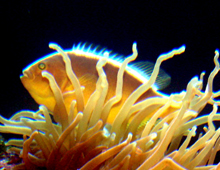Description: The Orange skunk clownfish, also known as the Skunk-striped anemonefish, is bright orange with a bold white stripe that starts between the middle of its snout, runs upward between its eyes, continues along both sides of its dorsal fin and then finally ends at the upper part of its tail fin. It has no white bars on its body or head; dorsal fin may be partially white.
Size: This species grows to about 5.5 inches (14 cm) in length.
Behavior: Like all other clownfish, the Orange skunk clownfish is a sequential hermaphrodite. There is one large dominant female, one smaller sexually active male and a few smaller males and juveniles living in their small group. When the dominate female perishes, the largest male will change sex and become the dominant female and then the next largest male will become the sexually active one. This clownfish is capable of living without a host anemone, however, it commonly has a symbiotic relationship with a host anemone. The anemone provides a safe place for the clownfish because its tentacles will inflict a painful sting to most other creatures. In return, the territorial Orange skunk clownfish will chase off fish that threaten to pick at the anemone and it also brings the anemone food.
Diet: This omnivore feeds on algae, crustaceans and zooplankton.
Senses: Clownfish, although poor swimmers, excrete a special actinian mucus that protects them
from the stinging tentacles of the host anemones.
Reproduction: Prior to spawning, males can be seen displaying for the females by erection of fins, chasing and preparing the nest site. Orange skunk clownfish lay eggs (an average of 300) on coral or a rock near the anemone. The eggs hatch in about seven to ten days. Both parents care for the developing embryos and can be seen carefully tending the eggs and protecting them from potential predators.
Habitat/range: They are found on coral reefs in the Indo-Pacific region.
Status: Listed as Least Concern on the IUCN Red List.



